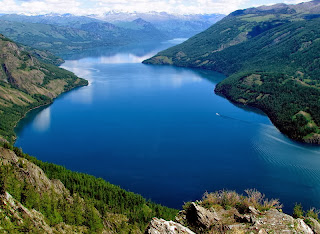Kanas (Also called Hanas which is the name used by local Kazakhsare) is a nature reserve which means beautiful, rich and mysterious in Mongolian, could be most fascinating resort in Northern Xinjiang. Kanas are located in the Altay Mountains of Northern Xinjiang in China. Travelers rave about the wonderful alpine scenery at R&R-perfect Kanas Lake, a long finger of a lake found in the southernmost reaches of the Siberian taiga ecosystem. The Kanas nature reserve bounding is the only one in China to border three other nations - Russia, Mongolia and Kazakhstan.
It is most popular natural ecosystem formed by lakes, glaciers, grasslands, forest, and rivers. But the main highlight of nature reserve is Kanas Lake, located 1,375 meters above sea level, and covers an area of 45.73 square KM. Kanas Lake is 140 KM away from Burqin County, and 246 kilometers away from Altay City. Well you can take a plane to Altay City or take a coach to Burqin County at Urumqi, and then rent a motorcar to get there. Moreover; there are free bus rides available after you buy the tickets of Kanas. The service is quiet good and all the places are quiet well connected. You can also ride horses with local guides. The attractiveness of Kanas Lake is more boosted by the changes in its color according to the season. During the thaw in May it is a deep grayish blue, which by June, when it reflects summers mountain greenery, has turned sky blue.
The long bean-shaped lake provides rise to the Kanas River which flows out for about 125 kilometer across pristine, alpine forest before discharging into the Irtysh at Burqin Town. In autumn, the attractive landscape bursts into a riot of colors with gold, red, blue and green. Many tourists to be here just to hoping for to catch a glimpse of the Kanas Lake Monster, a mythical beast that myriad tourists swore to have seen. It’s same to Scotland’s Loch Ness Monster. After 1980’s the hype of stories sightings have regularly appeared in Chinese media. July is the flooding season, when deluges from the White Lake upriver bleach Lake Kanas milky white. High rainfall in August deepens its color once more to an aqua green, which turns bright emerald in the drier months of September and October. Amongst the numerous contributing features to this marvel are the various minerals that are carried downstream from the upper rivers, the varying colors of plant life on the mountains around the lake, and the varying angle of sunshine on the water surface throughout the year.
These stories attract more tourists and settlers came to this area bringing countless journalists and conspiracy hounds although researchers have dismissed the Chinese Nessie as a large member of the salmon family. Apart the temptation of monster, Kanas Lake is breathtaking place with its vivid, minty green water surrounded with forest and snow packed mountains. There is a 2000-meters long bank of dead trees on the one side of the lake, which have accumulated over the years, carried by strong wind and waves. The massive dike of dead trees is an uncommon spectacle. In winter it is extremely cold, so be sure to take proper protection, it abruptly becomes excessively cold during the night. The beautiful Kanas Lake is also home of thousand Mongolians, whose stout log houses are clustered into numerous villages. They quite habitual of eat fish from the lake, keep herds cows and sheep, and trade animal products for wheat grown in the south. 3 to 4days' trekking around the area is the perfectionist way to witness the beauty and an extraordinary experience practiced by all backpackers who travel to Kanas.
July is the flooding season, when deluges from the White Lake upriver bleach Lake Kanas milky white. High rainfall in August deepens its color once more to an aqua green, which turns bright emerald in the drier months of September and October. Amongst the numerous contributing features to this marvel are the various minerals that are carried downstream from the upper rivers, the varying colors of plant life on the mountains around the lake, and the varying angle of sunshine on the water surface throughout the year.
























No comments:
Post a Comment